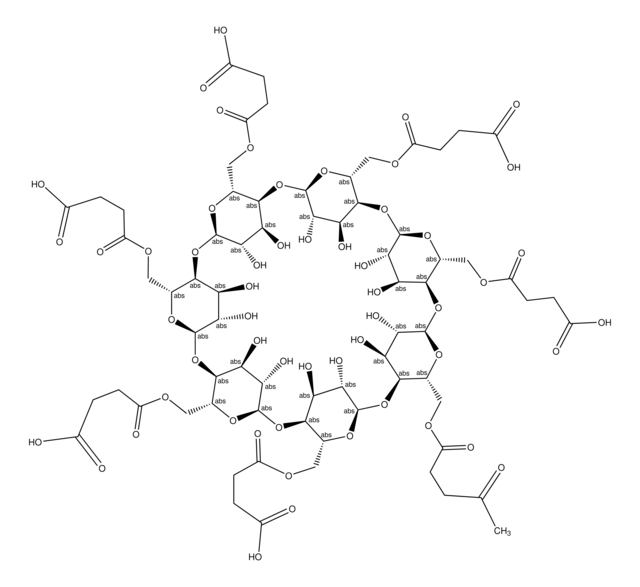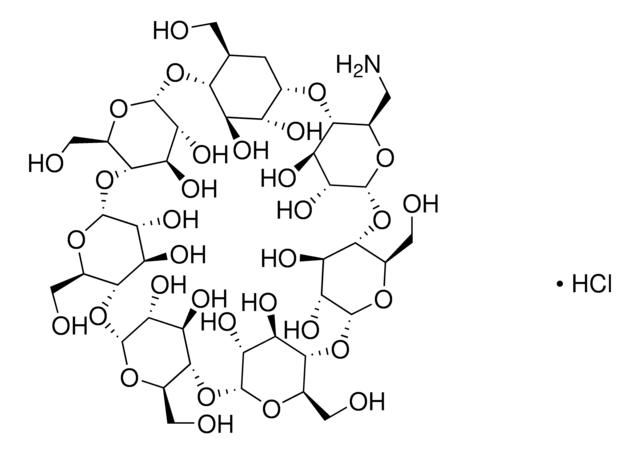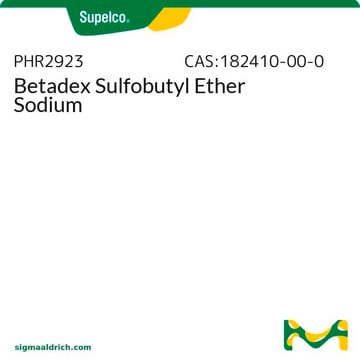21906
Carboxymethyl-β-cyclodextrin sodium salt
Synonim(y):
Sodium CM-β-Cyclodextrin
About This Item
Polecane produkty
Postać
solid
zanieczyszczenia
10% water
mp
~245 °C (dec.)
rozpuszczalność
H2O: 50 mg/mL, clear to slightly hazy, colorless
ciąg SMILES
O[C@H]1[C@H](O)[C@@H]2O[C@H]3O[C@H](COCC(O)=O)[C@@H](O[C@H]4O[C@H](COCC(O)=O)[C@@H](O[C@H]5O[C@H](COCC(O)=O)[C@@H](O[C@H]6O[C@H](COCC(O)=O)[C@@H](O[C@H]7O[C@H](COCC(O)=O)[C@@H](O[C@H]8O[C@H](COCC(O)=O)[C@@H](O[C@H]1O[C@@H]2COCC(O)=O)[C@@H](O)[C@@H]8O)[C@@H](O)[C@@H]7O)[C@@H](O)[C@@H]6O)[C@@H](O)[C@@H]5O)[C@@H](O)[C@@H]4O)[C@@H](O)[C@@H]3O
InChI
1S/C56H84O49/c57-22(58)8-85-1-15-43-29(71)36(78)50(92-15)100-44-16(2-86-9-23(59)60)94-52(38(80)31(44)73)102-46-18(4-88-11-25(63)64)96-54(40(82)33(46)75)104-48-20(6-90-13-27(67)68)98-56(42(84)35(48)77)105-49-21(7-91-14-28(69)70)97-55(41(83)34(49)76)103-47-19(5-89-12-26(65)66)95-53(39(81)32(47)74)101-45-17(3-87-10-24(61)62)93-51(99-43)37(79)30(45)72/h15-21,29-56,71-84H,1-14H2,(H,57,58)(H,59,60)(H,61,62)(H,63,64)(H,65,66)(H,67,68)(H,69,70)/t15-,16-,17-,18-,19-,20-,21-,29+,30+,31+,32+,33+,34+,35+,36+,37+,38+,39+,40+,41+,42+,43-,44-,45-,46-,47-,48-,49-,50-,51-,52-,53-,54-,55-,56-/m1/s1
Klucz InChI
WROHVVIPQXODQM-LYSKQWNXSA-N
Opis ogólny
Zastosowanie
Carboxymethyl-β-cyclodextrin (CMBCD) is used in the development of recognition and separation technologies to resolve enantiomers based on chiral properties and size. Carboxymethyl-β-cyclodextrin is used in chiral selection and separation by capillary electrophoresis. Carboxymethyl-β-cyclodextrin is used in the development of drug delivery vehicles such as nanocarriers and as a nucleic acid transfection agent.
Komentarz do analizy
Inne uwagi
Kod klasy składowania
11 - Combustible Solids
Klasa zagrożenia wodnego (WGK)
WGK 3
Temperatura zapłonu (°F)
Not applicable
Temperatura zapłonu (°C)
Not applicable
Środki ochrony indywidualnej
Eyeshields, Gloves, type N95 (US)
Certyfikaty analizy (CoA)
Poszukaj Certyfikaty analizy (CoA), wpisując numer partii/serii produktów. Numery serii i partii można znaleźć na etykiecie produktu po słowach „seria” lub „partia”.
Masz już ten produkt?
Dokumenty związane z niedawno zakupionymi produktami zostały zamieszczone w Bibliotece dokumentów.
Nasz zespół naukowców ma doświadczenie we wszystkich obszarach badań, w tym w naukach przyrodniczych, materiałoznawstwie, syntezie chemicznej, chromatografii, analityce i wielu innych dziedzinach.
Skontaktuj się z zespołem ds. pomocy technicznej








